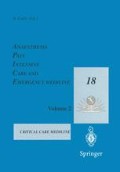Abstract
Postoperative acute pain is a syndrome, whose physiopathologic mechanisms are now well known: all of them result from surgical operations, which are invasive acts. Postoperative acute pain is semeiologically meaningless and physiologically useless; however, it is responsible for a range of nervous, hormonal and metabolic responses, which are unhealthy for patients and jeopardise their prognoses, since they entail longer hospital stays and, therefore, increased social costs. Nowadays, patients still regard this kind of pain as an inevitable part of the price to be paid for surgical treatments; moreover, medical and paramedical staff members often believe that pain is an inherent part of surgery and apply unsuitable approaches and treatments. Therefore, postoperative acute pain control units should be established in surgical departments, not only to treat such pain, but mainly to provide information, education and training.
Access this chapter
Tax calculation will be finalised at checkout
Purchases are for personal use only
Preview
Unable to display preview. Download preview PDF.
References
Italian Republic (2001) Act dated May 24, 2001. Agreement entered into by the Ministry of Health, the Regions, and the Autonomous Provinces on the guidelines relative to the project “Painless Hospital”. Official Journal of the Italian Republic; general series no. 149 (29/06/2001)
Ready LB, Oden R, Chadwich HS et al (1988) Development of an anesthesiology-based postoperative pain management service. Anesthesiology 68: 100–106
Rawal N, Berggren L (1994) Organization of acute pain service: a low cost model. Pain 57: 117–123
Cronin M, Redfern PA, Utting JE (1973) Psychiatry and postoperative complaints in surgical patients. Br J Anaesth 45: 879–884
Raja SN, Meyer RA, Campbell JN (1988) Peripheral mechanism of somatic pain. Anesthesiology 68: 571–580
Raja SN, Campbell JN, Meyer RA (1984) Evidence for different mechanism of primary and secondary hyperalgesia. Brain 107: 1179–1188
Besson JM, Chaouch A (1987) Peripheral and spinal mechanism of nociception. Physiol Rev 67: 67
Woolf CJ (1983) Evidence for a central component of post-injury pain hypersensitivity. Nature 306: 686–688
Liu H, Mantyh PW, Basbaum AI (1997) N MDA-receptor regulation of substance P release from primary afferent nociceptors. Nature 386: 721–724
Harris JA, Corsi M, Quartaroli M et al (1996) Upregulation of spinal glutamate receptor in chronic pain. Neuroscience 74: 7–12
Schaible HG, Jarrott B, Hope PJ, Duggan AW (1990) Release of immunoreactive substance P in the spinal cord during development of acute arthritis in the knee joint of the cat: a study with antibody microprobes. Brain Res 529: 214–223
Meller ST, Gebhart GF (1993) Nitric oxide ( NO) and nociceptive processing in the spinal cord. Pain 52: 127–136
Coderre TI (1993) The role of excitatory aminoacid receptors and intracellular messengers in persistent nociception after tissue injury in rats. Mol Neurobiol 7: 229–246
Woolf CJ (1989) Recent advances in the pathophysiology of acute pain. Br J Anaesth 63: 139–146
Hunt SP, Pini A, Evan G (1987) Induction of c-fos-like protein in spinal cord neurons following sensory stimulation. Nature 328: 632–634
Rawal N, Sjostrand U, Christofferson E et al (1984) Comparison of intramuscolar and epidural morphine for post-operative analgesia in grossly obese. Influence on post-operative ambulation and pulmonary function. Anesth Analg 63: 583–592
Donovan I, Alexander-Williams J (1976) Postoperative gastric retention and delayed gastric emptying. Surg Clin North Am 56: 1413
Pollock RE, Lotzova E, Stanford SD (1991) Mechanism of surgical stress impairment of human perioperative natural killer cell cytotoxicity. Arch Surg 126: 338–342
Tuman KJ, Spiess BD, McCarthy RJ, Ivankovich AD (1987) Effects of progressive blood loss on coagulation as measured by thromboelastography. Anesth Analg 66: 856–863
Garcia-Frade LJ, Landin L, Avello AG et al (1987) Changes in fibrinolysis in the intensive care patient. Thromb Res 47: 593–599
Ballantyne JC, Carr DB, De Ferranti S et al (1998) The comparative effects of post operative analgesic therapies on pulmonary outcome: cumulative meta-analyses of randomized, controlled trials. Anesth Analg 86: 598–612
Nolli M, Nicosia F (2000) Postoperative pain management. Aims and organization of a strategy for postoperative acute pain therapy. Minerva Anestesiol 66: 585–601
Editor information
Editors and Affiliations
Rights and permissions
Copyright information
© 2004 Springer-Verlag Italia, Milano
About this paper
Cite this paper
Galimberti, G., Piva, M., Gullo, A. (2004). Models of acute pain service. In: Gullo, A. (eds) Anaesthesia, Pain, Intensive Care and Emergency Medicine — A.P.I.C.E.. Springer, Milano. https://doi.org/10.1007/978-88-470-2189-1_22
Download citation
DOI: https://doi.org/10.1007/978-88-470-2189-1_22
Publisher Name: Springer, Milano
Print ISBN: 978-88-470-0235-7
Online ISBN: 978-88-470-2189-1
eBook Packages: Springer Book Archive

